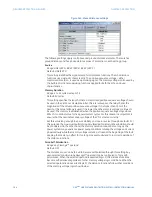
CHAPTER 7: PROTECTION
POWER SYSTEM
D90
PLUS
LINE DISTANCE PROTECTION SYSTEM – INSTRUCTION MANUAL
177
In conventional analog or electronic relays, the sum of the currents is obtained from an
appropriate external connection of all CTs through which any portion of the current for the
element being protected could flow. Auxiliary CTs are required to perform ratio matching if
the ratios of the primary CTs to be summed are not identical. In the D90
Plus
, provisions
have been included for all the current signals to be brought to the D90
Plus
device where
grouping, ratio correction and summation are applied internally via configuration settings.
A major advantage of using internal summation is that the individual currents are
available to the protection device; for example, as additional information to calculate a
restraint current, or to allow the provision of additional protection features that operate on
the individual currents such as breaker failure.
Given the flexibility of this approach, it becomes necessary to add configuration settings to
the platform to allow the user to select which sets of CT inputs will be added to form the
net current into the protected device.
The internal grouping of current and voltage signals forms an internal source. This source
can be given a specific name through the settings, and becomes available to protection
and metering element in the D90
Plus
. Individual names can be assigned to each source to
clearly identify them for later use. For example, in the scheme shown above, a source
configured as the sum of CT1 and CT2 can be assigned the name “Line Current”.
Once the sources have been configured, they are available as selections for the choice of
input signal for the protection elements and as metered quantities.
CT/VT input channel configuration
The previous section explains how the input channels are identified and configured to the
specific application instrument transformers and the connections of these transformers.
The specific parameters to be used by each measuring element and comparator, and
some actual values are controlled by selecting a specific source.
The source is a logical group of current and voltage input channels selected by the user to
facilitate this selection. With this mechanism, a user does not have to make multiple
selections of voltage and current for those elements that need both parameters, such as a
distance element or a watt calculation. It also gathers associated parameters for display
purposes. The basic idea of arranging a source is to select a point on the power system
where information is of interest. An application example of the grouping of parameters in a
source is a transformer winding, on which a three-phase voltage is measured, and the sum
of the currents from CTs on each of two breakers is required to measure the winding
current flow.
Signal source settings
Select the
Settings > Protection > Power System > Signal Sources
menu item to open the
protection sources configuration window.
Figure 156: Protection sources configuration settings
Settings are available for all three sources. The “LINE”, “BKR1”, and “BKR2” text items can
be replaced by with a user-defined name to uniquely identify the associated source.















































